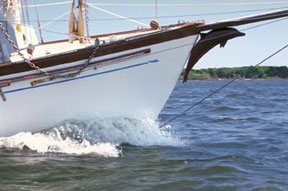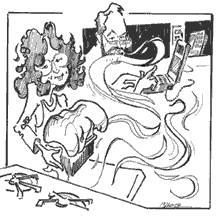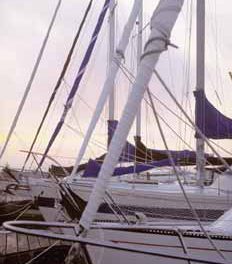
Tried and trusted old fittings give character to modern yachts
If you remember when all sailboats had wooden spars, manila lines, galvanized fittings, and cotton sails, chances are you have problems with your waistline, your hairline, and the number of teeth you can call your own. Those of us who fit this category have a special feeling for those sailboats of our youth, but those fond memories don’t include the maintenance involved in boats of that period.
When people see our schooner sail by, they see a boat from the turn of the century: a schooner rig with bowsprit, figurehead, bumpkin, belaying pins, wooden blocks, bronze portholes, lazy-jacks, and a graceful sheer. Yet she’s only 21 years old, with fiberglass hull, aluminum spars, and modern conveniences throughout – a modern version of a small Down East schooner of the last century. She’s one of the breed sailors call “character boats,” befitting her skipper. Boats such as this are the “rediscovery” in fiberglass of traditional cruising boats, such as schooners, catboats, Friendship sloops, and other designs from the past.
While the conscious mind is thinking, “She looks dated . . . slow,” sneaking into the subconscious are thoughts of coastal trading, Tahiti, and the whole mystique of other times, faraway places, and nostalgia. But traditional beauty doesn’t necessarily mean being impractical.

Bowsprits
Take the bowsprit, for example. On our schooner it provides a sailplan longer than the boat’s hull. With a lower center of effort there is less heeling, and more sail can be carried. This translates into drive power.
When tied up at a mooring buoy in an area with wind, current, and tide changes, a “bull rope” from the tip of the bowsprit can prevent the hull from striking the mooring buoy. This bull rope consists of an extra line from the ring of the buoy to the tip of the bowsprit, with just enough tension to keep the mooring buoy away from the bow.
Bowsprits traditionally found homes on cruising boats, but then for several decades they were abandoned. In the last few years, a resurgence in the use of bowsprits has occurred in reproductions of old designs as well as in the racing classes that allow them. With a bowsprit, more of the headsail is free from interference by the main, and in fresh winds the center of effort, which is farther forward, reduces weather helm and pressure on the rudder.

In many racing boats, the bowsprit is made retractable, either into the hull or along the deck, and unguyed carbon-fiber bowsprits are now emerging on the scene.
Our solid teak bowsprit provides a perfect platform on which to sit and watch the bow wave or the dolphins. Besides, without a bowsprit where would we put the figurehead?

The replica of the HMS Bounty figurehead stands as a proud lookout on a reproduction of Captain Bligh’s Bounty, built in 1960 in Nova Scotia.
Figureheads
A millennium before Christ, the Egyptians carved the heads of deities on the bows of their ships, and the Romans, Greeks, and Phoenicians carried on this tradition, dedicating their ships to their gods and goddesses in the hope of ensuring safe voyages. The “dragon ships” of the Vikings were adorned with menacing snarling dragon heads carved from oak which were intended to terrify the raiders’ victims and to guard against evil spirits at sea. The power of figureheads was thought to be so great that at one time Iceland insisted that foreign ships remove them before entering her waters.
Captain Bligh reported that the Tahitians were fascinated with the figurehead on the HMS Bounty (see photo on Page 48). He described it as “a pretty figure of a woman in a riding habit,” who was lifting her skirts over the seas with her right hand as she looked ahead of the ship. This painted likeness was the first representation of an Englishwoman the Tahitians had ever seen. Bligh wrote: ” … and they kept gazing at it for hours.”
Although a century or two ago figureheads became merely ornamental, many American commercial, and even Naval, ships were still sent to sea with elaborate carvings at their bows. The frigate Constitution was launched in 1797 adorned with a bust of Hercules. But Hercules was not up to the foray with the Barbary Coast pirates at Tripoli, where the figurehead was destroyed.
Our schooner, Delphinus, is named for the constellation of the dolphin and, therefore, sports a carved teak figurehead of a leaping dolphin beneath her bowsprit (pictured at left above). It serves not only as a decorative appendage, but also as a bowsprit brace. It’s a great hit both on the water and at dockside. It seems to have a special attraction for children.
As enlightened sailors, we know our figurehead is purely decorative, yet sometimes there’s the feeling of a “presence” at our bow, guiding us through foggy and unfamiliar waters.

while admiring the figurehead on Delphinus, the author’s granddaughter, Jenny, becomes a figurehead in her own right.
Belaying pins
Another rare item on sailing vessels nowadays is the belaying pin. The closest most sailors come to them is during visits to the tall ships or when watching a deck fight in an old pirate movie. Who would think of using them on today’s craft? They’re out of fashion, impractical and archaic . . . and I love them.
In the olden days, belaying pins were made of hardwood, usually locust, and sometimes bronze, iron, or brass. They were used to secure and store lines, particularly the running rigging. Securing a line to a belaying pin is the same as to a cleat. The added advantage is the speed and ease with which a line that is belayed, or made fast, can be released. When the pin is pulled, the line falls to the deck in an untangled flaked-out pattern, ready to run freely.
Belaying pins are used to provide increased friction to control a line by taking a single round-turn and one or more “S” turns around the pin. This is to “belay” the line. When a single hitch or slip-hitch is added to the belayed turns, the line is “made fast” (see diagrams).
The large sailing ships of yesteryear frequently set their belaying pins in holes in the “pin-rail,” which was fixed inside the bulwarks or incorporated as part of the bulwark or main rail as in the photo below. Short pin-rails, fastened to the standing rigging are called “pin-racks,” and around the mast on deck, rectangular or U-shaped racks, called “fife-rails,” are used to make fast and store halyards. A variation of the fife-rail is used on modern sailboats, where the mast pulpit is combined with a small pin-rack. A “spider band” was sometimes fitted around the mast a little above deck level, with holes for the belaying pins. This was sometimes called a “spider hoop” or “spider iron.” Stanchion-mounted pin-racks are used for storing coils of line and are both decorative and utilitarian.
For the do-it-yourselfer, belaying pins can be turned out on the most basic of lathes from brass, bronze, or scrap hardwood. But remember, those metal ones don’t float! With today’s teak prices, it’s nice to know that those teak scraps can be turned into beautiful belaying pins for onboard use or home decoration.
Our schooner is rigged in the old Grand Banks manner with no sheet winches. To attain mechanical advantage, multiple-part block and tackle is used for each of the sheets. This presents the problem of long coils of line ending up in the cockpit due to the 4:1 block ratio. This would be a colossal spaghetti pot if it weren’t for the pin-racks we’ve installed, not for belaying as such, but rather as an attractive and practical way of keeping our sheets out from underfoot.
When I built our schooner, I added belaying pins because they “belonged” on a schooner with traditional lines, not because I had ever used them before. Now, I couldn’t imagine sailing without them. As well as being useful, they add that needed touch of character. And they’re good for dispatching that fish you caught on the lure trailing astern or for fighting off pirates.

The bumpkin
And, oh yes, the bumpkin (sometimes called boomkin or bumkin). This is a short boom, frequently V-shaped, extending from the stern, to which the backstay or mizzen sheet block is attached. When used for the backstay, along with an associated bumpkin stay, it allows for a longer mainsail boom and frequently eliminates the need for running backstays. It provides a more practical lead angle for the mizzen sheet for a ketch or yawl. On our schooner, the mainsail extends all the way to the stern of the boat, with the bumpkin keeping the permanent backstay well out of the way (see photo).
For years we looked for a retirement boat that would fill our specs until we happened to stumble across our little schooner design from the board of Ted Brewer. It meets our needs completely, and seems appropriate for our vintage years. When we sail by with everything up, people turn to watch or take pictures. With that gray-haired and bearded character at the wheel, they probably think it’s an apparition from the past. After all, how often do you see a small schooner with bowsprit, wood blocks, figurehead, belaying pins, and bumpkin?
Article from Good Old Boat magazine, November/December 2001.





